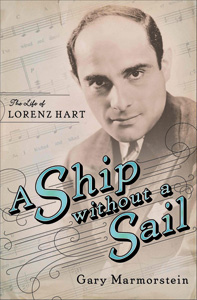Lyricist Lorenz Hart’s biography is music to the ears
Published December 26, 2012
From their first hit, “The Garrick Gaieties” in 1925, to a revival of “A Connecticut Yankee” in 1943, composer Richard Rodgers and lyricist Lorenz Hart wrote more than 800 songs for nearly 30 shows and countless Hollywood films. These songs included such standards as “Blue Moon,” “My Romance,” “My Funny Valentine,” “Bewitched, Bothered, and Bewildered,” “Where or When,” and “Dancing on the Ceiling.”
No wonder Variety, Broadway’s “bible” would often start its lead story with these eight words: “It’s Chic, it’s Smart; It’s Rodgers and Hart.” Many music critics consider Hart and Cole Porter the two greatest lyricists of the Great American Songbook.
Gary Marmorstein, author of “Hollywood Rhapsody” and “The Label,” and film, theater, and popular music contributor to many publications including The New York Times and the Los Angeles Times, has written what should be a definitive biography of Lorenz Hart, A Ship Without a Sail: The Life of Lorenz Hart (Simon and Schuster, $34.99, 531 pages).
Hart, the son of Jewish immigrants, was born on May 2, 1895, and grew up in New York City. His father was a con man who was convicted numerous times of fraud but always managed to escape prison sentences. Hart, known as Larry, lived with his doting mother almost his entire life. He always possessed a propensity for wordplay, and was inspired by such writers as Shakespeare, William Butler Yeats, and W. S. Gilbert. While still a teenager, Hart was writing lyrics and creating shows for summer camps in the Adirondacks. He met his future collaborator, Richard Rodgers, at Columbia University, where the duo began to write varsity shows.
Marmorstein called Rodgers and Hart a perfect musical match. But temperamentally and physically they were complete opposites. Rodgers, claims the author, was “precise, punctual, heterosexual, handsome, and eager to be accepted by society.” Hart was so short (barely 5-feet tall), that Rodgers, not always the most tactful person, called him “the shrimp.” Hart was also alcoholic, homosexual, horrified of solitude and careless, especially with his money. Throughout most of their relationship Rodgers, the disciplined composer, spent much of his time literally “hunting” for his erratic and unreliable lyricist.
After years of drinking and unhealthy living, Lorenz Hart died November 22, 1943, of bilateral bronchopneumonia. There is little doubt alcoholism contributed greatly to his death at the age of 42. Minutes before his passing, he is reputed to have asked his nurse a final question. “What have I lived for?”
Despite Rodgers’ ambivalent feelings toward his collaborator, no one grieved more deeply over Hart’s demise than Rodgers. As he approached Hart’s casket at New York’s Universal Chapel, Rodgers, who was known to be impassive and unemotional, took one last look at his partner of two decades, then turned away and collapsed, sobbing into the arms of his wife, Dorothy.
Lorenz Hart, for all of his shortcomings, was a true genius, and Gary Marmorstein’s book is well researched, and highly readable. The title of this biography is one of Hart’s most poignant lyrics, and in many ways aptly describes Hart, the brilliant but troubled man behind many of Richard Rodgers’ lovely ballads. “Still alone at sea/still there’s no one to care for me/Where there’s no hand to hold my hand/life is a loveless tale/for a ship without a sail.”
Marmorstein maintains that although Cole Porter was seen as Hart’s equal, he ranks Hart above Porter. Porter’s lyrics, argues the author, greet party guests who are well-turned out and comfortable, and who like to poke fun at fellow guests. On the other hand, contends Marmolstein, Hart’s lyrics reveal what it is like to be excluded from that party; how it feels to be standing outside looking in; to feel undesirable and insignificant. “No other lyricist,” wrote Marmorstein, “has ranged so intelligently—or emotionally—between the extremes of enthralling new romance, and lonely, unforgiving desolation.”
The book is not without its shortcomings. It is a long primarily because the author is “too thorough.” He is so captivated by the minutiae of Hart’s career that he has included dates, business deals, casting dilemmas, and opening nights of every one of Rodgers’ and Hart’s Broadway productions. The result is that he has failed to solve a major mystery—how could a man with no close relationships write some of the most bittersweet love lyrics of the American songbook. Marmorstein should have concentrated on the three Rodgers-Hart productions that were the most innovative, high quality musicals: “On Your Toes,” which introduced real ballet to musical comedy and used it as a plot element; “The Boys From Syracuse,” which was a true farce musical comedy; and “Pal Joey,” which for the first time introduced realistic, disreputable characters and subjects onto the musical stage.
Regardless of this flaw, “A Ship Without a Sail” is highly recommended reading. This is a special nostalgic treat for anyone who might wonder where the great songs are. They are in the Rodgers and Hart songbook.














